The Effects of Touch Versus Non-Touch Interfaces On Online Shopping Experience
COM1 Level 2
Video Conference Room, COM1-02-13


Abstract:
The past few years have witnessed that consumers' online shopping has gradually shifted from non-touch interfaces (e.g., desktops and laptops with a mouse) to touch interfaces (e.g., smartphones and iPads). Recent studies have shown that the mere change of the interface can influence consumers' online shopping experiences because of the different response modes. When consumers use a touch interface, they usually reach out their hands and use their fingers to touch the image of the product presented, which is a kind of "direct touch". In contrast, when consumers use a non-touch computer interface, they use a mouse to manipulate the product, which is more indirect as the response is mediated by the mouse. Although previous literature has offered some insightful findings of how touch versus non-touch interfaces influence consumer perception and behavior, there are still some limitations.
First, the theory of grounded cognition suggests that people's mental activity is "embodied" such that bodily state or action can impact human cognition. Given the different response modes, the bodily states and actions of using touch and non-touch interfaces are quite different. Therefore, computer interfaces may impact the human cognitive process. However, extant literature has yet to systematically explore this possibility. Second, processing online product information often involves both visual and tactile activities, which is especially so when one uses the touch interface. Sensory marketing literature has long predicted the powerful influence of multi-sensory interaction. Thus, work is needed to investigate the cross-modality effect between product visual depiction and tactile interface. To address the research gaps, two empirical studies are proposed by using multiple methods.
The first study attempts to examine how touch versus non-touch computer interfaces influences the ways online consumers construe products. Drawing on the literature on mental simulation and construal level, we propose that touch (vs. non-touch) interface can result in low-construal level or concrete thinking and shift consumers' attention to product feasibility considerations than desirability considerations. Three experiments have been conducted to examine the association between interface and construal level: touch interfaces make participants describe activities more concretely (vs. abstractly) (experiment 1a), think more about how (vs. why) to use a product (experiment 1b), and be less inclusive in the category inclusiveness task (experiment 2). Experiment 2 also demonstrates that participants prefer a product with high feasibility (usage convenience) than the one with high desirability (functionality) on touch (vs. non-touch) interfaces. Two more experiments are proposed to exclude the confounding effect of screen size and examine the mediated effect of construal level.
The second study is trying to examine the cross-modality effect of product visual depiction (i.e., orienting a product to one's dominant hand) and computer interface (i.e., touchscreen vs. mouse-click). Based on the theory of grounded cognition, we propose that on touch (vs. non-touch) interfaces, the match (vs. mismatch) between product orientation and handedness can lead to higher product mental interaction and subsequently affect consumer evaluation and choice. Experiment 1 demonstrates that when using a touchscreen, participants evaluate a product oriented to their dominant (vs. non-dominant) hands and its advertisement more favorable, whereas, this effect disappears for participants who use non-touch interfaces. Mental product interaction accounts for this joint effect. Similarly, experiment 2 demonstrates that touch (vs. non-touch) interfaces lead to more choice of products oriented to participants' dominant (vs. non-dominant) hands. However, this effect is mitigated by distancing the choice button from the product picture. In the future experiment, we propose to use the method of Event-related Potentials (ERPs) to measure participants' brain activity to enhance our understanding of the cross-modality effect.

